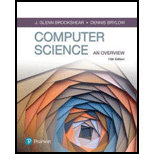
Computer Science: An Overview (13th Edition) (What's New in Computer Science)
13th Edition
ISBN: 9780134875460
Author: Glenn Brookshear, Dennis Brylow
Publisher: PEARSON
expand_more
expand_more
format_list_bulleted
Concept explainers
Question
Chapter 8.5, Problem 1QE
Program Plan Intro
Data type:
The storage classification of data which is defines the type of data to be stored in the system such as integer, float, and Boolean or character is called data type. These data types provide primitive data types in most of the
Expert Solution & Answer
Want to see the full answer?
Check out a sample textbook solution
Students have asked these similar questions
Dijkstra's Algorithm (part 1). Consider the network shown below, and Dijkstra’s link-state algorithm. Here, we are interested in computing the least cost path from node E (note: the start node here is E) to all other nodes using Dijkstra's algorithm. Using the algorithm statement used in the textbook and its visual representation, complete the "Step 0" row in the table below showing the link state algorithm’s execution by matching the table entries (i), (ii), (iii), and (iv) with their values. Write down your final [correct] answer, as you‘ll need it for the next question.
4. |z + 5 - 5i| = 7
14.
dz,
C: |z❘
C: |z❘ = 0.6
ze² - 2iz
H
Chapter 8 Solutions
Computer Science: An Overview (13th Edition) (What's New in Computer Science)
Ch. 8.1 - Give examples (outside of computer science) of...Ch. 8.1 - Prob. 2QECh. 8.1 - Prob. 3QECh. 8.1 - Prob. 4QECh. 8.1 - Prob. 5QECh. 8.2 - In what sense are data structures such as arrays,...Ch. 8.2 - Prob. 2QECh. 8.2 - Prob. 3QECh. 8.3 - Prob. 1QECh. 8.3 - Prob. 2QE
Ch. 8.3 - Prob. 3QECh. 8.3 - Prob. 4QECh. 8.3 - Modify the function in Figure 8.19 so that it...Ch. 8.3 - Prob. 7QECh. 8.3 - Prob. 8QECh. 8.3 - Draw a diagram representing how the tree below...Ch. 8.4 - Prob. 1QECh. 8.4 - Prob. 2QECh. 8.4 - Prob. 3QECh. 8.4 - Prob. 4QECh. 8.5 - Prob. 1QECh. 8.5 - Prob. 3QECh. 8.5 - Prob. 4QECh. 8.6 - In what ways are abstract data types and classes...Ch. 8.6 - What is the difference between a class and an...Ch. 8.6 - Prob. 3QECh. 8.7 - Suppose the Vole machine language (Appendix C) has...Ch. 8.7 - Prob. 2QECh. 8.7 - Using the extensions described at the end of this...Ch. 8.7 - In the chapter, we introduced a machine...Ch. 8 - Prob. 1CRPCh. 8 - Prob. 2CRPCh. 8 - (Asterisked problems are associated with optional...Ch. 8 - Prob. 4CRPCh. 8 - (Asterisked problems are associated with optional...Ch. 8 - Prob. 6CRPCh. 8 - Prob. 7CRPCh. 8 - Prob. 8CRPCh. 8 - Prob. 9CRPCh. 8 - Prob. 10CRPCh. 8 - Prob. 11CRPCh. 8 - Prob. 12CRPCh. 8 - Prob. 13CRPCh. 8 - Prob. 14CRPCh. 8 - Prob. 15CRPCh. 8 - Prob. 16CRPCh. 8 - Prob. 17CRPCh. 8 - Prob. 18CRPCh. 8 - Design a function to compare the contents of two...Ch. 8 - (Asterisked problems are associated with optional...Ch. 8 - (Asterisked problems are associated with optional...Ch. 8 - Prob. 22CRPCh. 8 - Prob. 23CRPCh. 8 - Prob. 24CRPCh. 8 - (Asterisked problems are associated with optional...Ch. 8 - Prob. 26CRPCh. 8 - Prob. 27CRPCh. 8 - Prob. 28CRPCh. 8 - Prob. 29CRPCh. 8 - Prob. 30CRPCh. 8 - Design a nonrecursive algorithm to replace the...Ch. 8 - Prob. 32CRPCh. 8 - Prob. 33CRPCh. 8 - Prob. 34CRPCh. 8 - Draw a diagram showing how the binary tree below...Ch. 8 - Prob. 36CRPCh. 8 - Prob. 37CRPCh. 8 - Prob. 38CRPCh. 8 - Prob. 39CRPCh. 8 - Prob. 40CRPCh. 8 - Modify the function in Figure 8.24 print the list...Ch. 8 - Prob. 42CRPCh. 8 - Prob. 43CRPCh. 8 - Prob. 44CRPCh. 8 - Prob. 45CRPCh. 8 - Prob. 46CRPCh. 8 - Using pseudocode similar to the Java class syntax...Ch. 8 - Prob. 48CRPCh. 8 - Identify the data structures and procedures that...Ch. 8 - Prob. 51CRPCh. 8 - In what way is a class more general than a...Ch. 8 - Prob. 53CRPCh. 8 - Prob. 54CRPCh. 8 - Prob. 55CRPCh. 8 - Prob. 1SICh. 8 - Prob. 2SICh. 8 - In many application programs, the size to which a...Ch. 8 - Prob. 4SICh. 8 - Prob. 5SICh. 8 - Prob. 6SICh. 8 - Prob. 7SICh. 8 - Prob. 8SI
Knowledge Booster
Learn more about
Need a deep-dive on the concept behind this application? Look no further. Learn more about this topic, computer-science and related others by exploring similar questions and additional content below.Similar questions
arrow_back_ios
SEE MORE QUESTIONS
arrow_forward_ios
Recommended textbooks for you
 New Perspectives on HTML5, CSS3, and JavaScriptComputer ScienceISBN:9781305503922Author:Patrick M. CareyPublisher:Cengage Learning
New Perspectives on HTML5, CSS3, and JavaScriptComputer ScienceISBN:9781305503922Author:Patrick M. CareyPublisher:Cengage Learning Systems ArchitectureComputer ScienceISBN:9781305080195Author:Stephen D. BurdPublisher:Cengage Learning
Systems ArchitectureComputer ScienceISBN:9781305080195Author:Stephen D. BurdPublisher:Cengage Learning C++ for Engineers and ScientistsComputer ScienceISBN:9781133187844Author:Bronson, Gary J.Publisher:Course Technology Ptr
C++ for Engineers and ScientistsComputer ScienceISBN:9781133187844Author:Bronson, Gary J.Publisher:Course Technology Ptr C++ Programming: From Problem Analysis to Program...Computer ScienceISBN:9781337102087Author:D. S. MalikPublisher:Cengage Learning
C++ Programming: From Problem Analysis to Program...Computer ScienceISBN:9781337102087Author:D. S. MalikPublisher:Cengage Learning Microsoft Visual C#Computer ScienceISBN:9781337102100Author:Joyce, Farrell.Publisher:Cengage Learning,
Microsoft Visual C#Computer ScienceISBN:9781337102100Author:Joyce, Farrell.Publisher:Cengage Learning,

New Perspectives on HTML5, CSS3, and JavaScript
Computer Science
ISBN:9781305503922
Author:Patrick M. Carey
Publisher:Cengage Learning

Systems Architecture
Computer Science
ISBN:9781305080195
Author:Stephen D. Burd
Publisher:Cengage Learning

C++ for Engineers and Scientists
Computer Science
ISBN:9781133187844
Author:Bronson, Gary J.
Publisher:Course Technology Ptr


C++ Programming: From Problem Analysis to Program...
Computer Science
ISBN:9781337102087
Author:D. S. Malik
Publisher:Cengage Learning

Microsoft Visual C#
Computer Science
ISBN:9781337102100
Author:Joyce, Farrell.
Publisher:Cengage Learning,